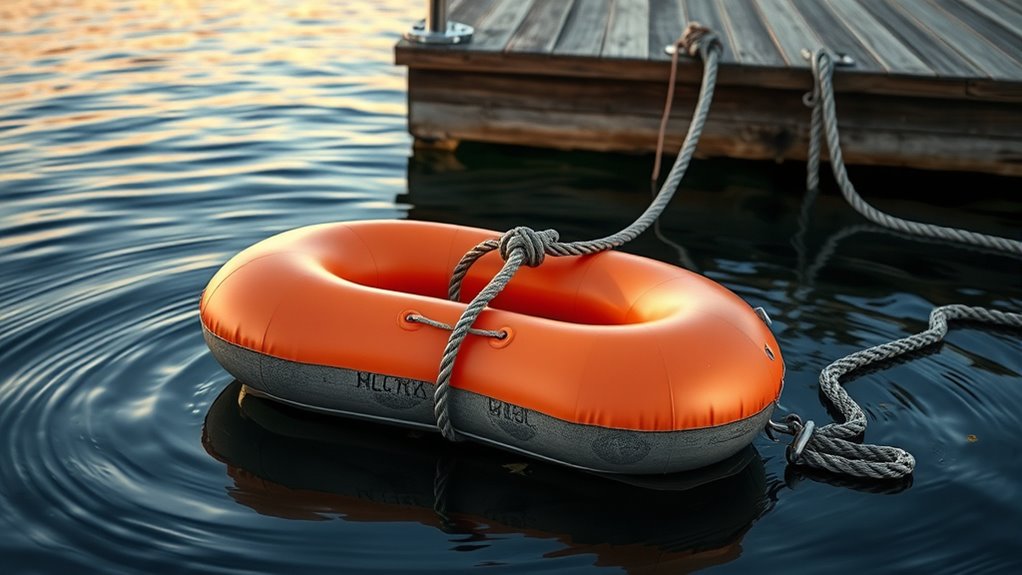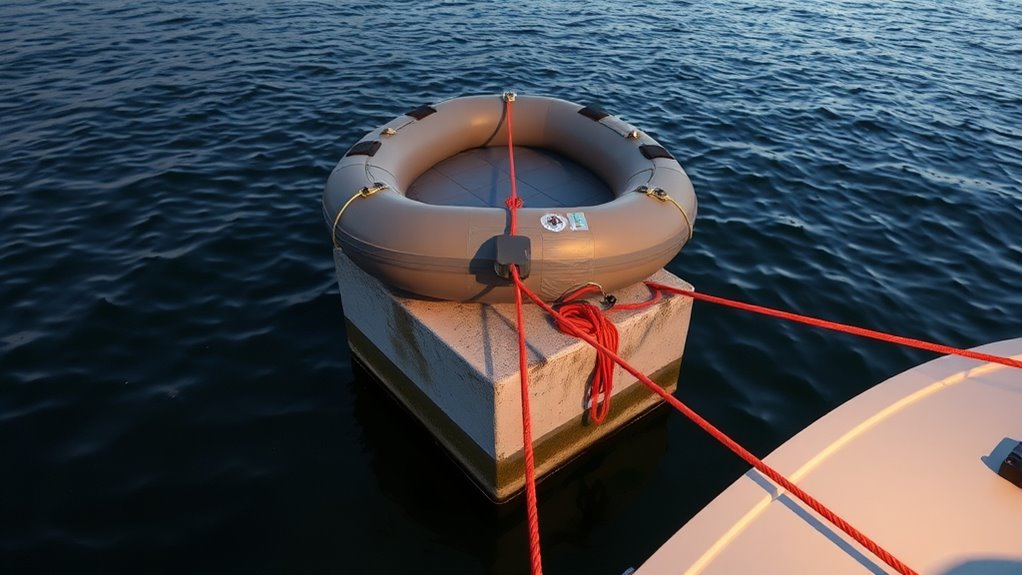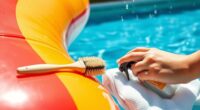To secure floats overnight safely, guarantee you use heavy-duty anchors like concrete blocks or sandbags tied securely with durable ropes or chains. Regularly check all connections and inspect the floats for cracks or damage. Position your floats in sheltered areas and reinforce anchors if storms are forecasted. Removing loose items and adding secondary anchors can boost stability. For more detailed tips on maintaining and upgrading your setup, keep exploring ways to protect your floats effectively.
Key Takeaways
- Use heavy-duty anchors like concrete blocks or sandbags for stable, secure attachment.
- Regularly inspect and tighten all connections, especially after storms or high winds.
- Choose sheltered locations and avoid exposed areas to minimize weather-related risks.
- Install secondary anchors or tie-downs for added security in storm-prone conditions.
- Remove loose items and ensure floats are in good repair to prevent damage or hazards overnight.

If you’re planning to leave your floats overnight, securing them properly is crucial to prevent theft or damage. Proper float maintenance isn’t just about keeping them clean and functional; it also involves making sure they stay safely anchored during the night. Weather preparedness plays a critical role here, as unexpected storms or strong winds can quickly dislodge unsecured floats, causing potential damage or safety hazards. Taking the right precautions helps protect your investment and ensures your floats remain ready for use when you need them.
Secure your floats overnight with proper anchoring and weather precautions to prevent theft and damage.
Start by choosing the right anchoring system. Heavy-duty anchors, such as concrete blocks or sandbags, are effective because they add weight and stability. Attach your floats securely to these anchors using durable ropes or chains, making sure they’re tight enough to prevent drifting but not so tight that they cause stress on the float’s structure. Regular float maintenance means inspecting these connections frequently, especially after storms or heavy winds, to confirm they’re intact and secure.
Weather preparedness is essential when securing floats overnight. Before leaving your floats, check the local weather forecast. If high winds, heavy rain, or storms are predicted, take extra steps to reinforce your anchors or consider bringing the floats ashore temporarily. Strong winds can create forceful currents that easily shift unsecured floats, so it’s always better to be cautious. If you leave your floats in the water, ensure they’re positioned in a sheltered area, away from potential hazards like boat traffic or debris that could cause damage during rough weather.
Utilize additional safety measures when possible. Installing tie-downs or secondary anchors provides an extra layer of security. For floats in open water, consider using mooring buoys designed for storm conditions. These are specifically made to withstand harsh weather and can keep your floats securely in place. Also, remove any loose items or accessories from your floats that could become projectiles or get caught during adverse weather. Proper float maintenance includes making sure the float’s surface is in good condition, with no cracks or leaks, which could worsen if exposed to moisture or storms overnight.
Finally, document your anchoring setup with photos and notes, so you know exactly what to do if you need to adjust or repair anything after bad weather passes. Doing so ensures you’re always prepared and reduces the risk of losing your floats or causing damage. Additionally, understanding the stability of your floats can help you plan better for different weather conditions. By combining diligent float maintenance with weather preparedness, you’ll greatly enhance the safety and security of your floats overnight, giving you peace of mind and protecting your equipment from preventable issues.
Frequently Asked Questions
Can I Leave My Float Unattended for Multiple Nights?
You shouldn’t leave your float unattended for multiple nights. Proper float maintenance and anchor selection are vital for safety and stability. Make certain your anchor is strong enough for the seabed conditions, and check it regularly to guarantee it stays secure. Leaving your float unattended increases the risk of drifting or damage. Always monitor your float, especially if you’re planning to be away for an extended period, to prevent accidents and maintain safety.
What Weather Conditions Are Safest for Overnight Float Anchoring?
You’ll want to anchor your float during stable weather, as studies show 70% of accidents happen in gusty conditions. The safest weather for overnight anchoring involves light winds below 10 knots and minimal wave activity. Calm, clear nights with steady conditions help prevent drifting or damage. Always check local weather forecasts before anchoring, and avoid high wind or storm predictions to keep your float secure and safe overnight.
How Do I Prevent Floats From Drifting During Storms?
During storms, you prevent floats from drifting by performing regular float maintenance and checking your anchor selection. Use a heavy-duty anchor suitable for the seabed type, ensuring it holds firmly. Always verify the anchor’s grip and adjust the scope of your rope or chain to maintain tension. Keep a close eye on weather updates, and if conditions worsen, consider repositioning or reinforcing your anchor to stay secure.
Is There a Recommended Weight for Anchoring Equipment?
Think of anchoring weight as the backbone of float stability—you want enough to hold firm without overburdening your float. For most cases, a weight between 10 and 20 pounds often does the trick, but it depends on the size of your float and water conditions. Always choose an anchoring weight that provides security without risking damage or excessive strain, ensuring your float stays put through storms and calm days alike.
What Safety Precautions Should I Take When Anchoring Alone?
When anchoring alone, you should always check your float’s buoyancy adjustments before settling in. Make certain the anchor line is secure and properly weighted for float maintenance. Keep a backup plan, like a secondary anchor or extra line, in case of shifting or drifting. Stay alert for weather changes and regularly monitor your float’s position. This way, you maintain safety and stability, preventing accidents overnight.
Conclusion
By following these anchoring tips, you guarantee your floats stay safe overnight, giving you peace of mind. Remember, using proper knots and secure attachments can prevent drifting or accidents. Did you know that improperly secured floats can drift up to 50 meters during a storm? That’s a lot of lost equipment and potential hazards. So, take the extra time to secure your floats properly—your safety and peace of mind depend on it.










